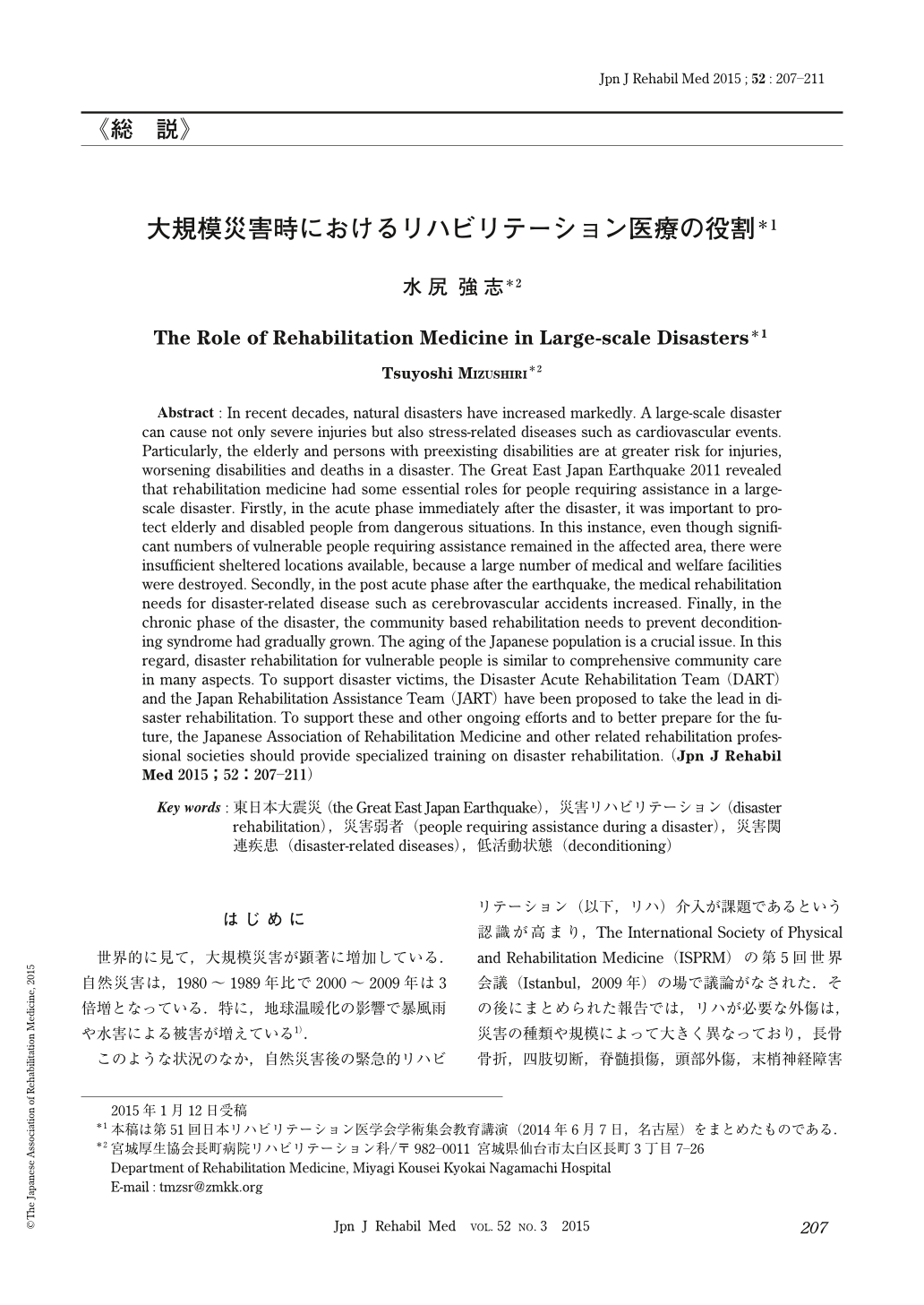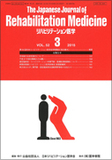Japanese
English
- 販売していません
- Abstract 文献概要
- 1ページ目 Look Inside
- 参考文献 Reference
はじめに
世界的に見て,大規模災害が顕著に増加している.自然災害は,1980〜1989年比で2000〜2009年は3倍増となっている.特に,地球温暖化の影響で暴風雨や水害による被害が増えている1).
このような状況のなか,自然災害後の緊急的リハビリテーション(以下,リハ)介入が課題であるという認識が高まり,The International Society of Physical and Rehabilitation Medicine(ISPRM)の第5回世界会議(Istanbul,2009年)の場で議論がなされた.その後にまとめられた報告では,リハが必要な外傷は,災害の種類や規模によって大きく異なっており,長骨骨折,四肢切断,脊髄損傷,頭部外傷,末梢神経障害などが含まれていることがわかった.また,災害以前から障害を持っている者は,慢性障害の悪化だけでなく,外傷や死亡のリスクが高いことも示された2).
日本では,阪神淡路大震災の教訓をふまえ,救命・救護を目的としたDisaster Medical Assistance Team(DMAT)が制度化されている.DMATは,多発外傷,クラッシュ症候群など外傷系傷病者への救命救急対応が主な任務であり,リハ医療としても,外傷系患者への対応に急性期から関わることが望ましい.一方,4人に1人が65歳以上という高齢社会に突入する時代背景を考えると,災害弱者に対する援助という立場で災害時リハを論議することも重要となっている.
当院は,東日本大震災被災県にあるリハ医療機関として災害弱者への支援を行った3).この経験をふまえ,避難行動要支援者への援助,災害関連疾患への対応,低活動状態による生活機能低下への備えという3つの視点で大規模災害時におけるリハ医療の役割について本稿をまとめた.
Abstract : In recent decades, natural disasters have increased markedly. A large-scale disaster can cause not only severe injuries but also stress-related diseases such as cardiovascular events. Particularly, the elderly and persons with preexisting disabilities are at greater risk for injuries, worsening disabilities and deaths in a disaster. The Great East Japan Earthquake 2011 revealed that rehabilitation medicine had some essential roles for people requiring assistance in a large-scale disaster. Firstly, in the acute phase immediately after the disaster, it was important to protect elderly and disabled people from dangerous situations. In this instance, even though significant numbers of vulnerable people requiring assistance remained in the affected area, there were insufficient sheltered locations available, because a large number of medical and welfare facilities were destroyed. Secondly, in the post acute phase after the earthquake, the medical rehabilitation needs for disaster-related disease such as cerebrovascular accidents increased. Finally, in the chronic phase of the disaster, the community based rehabilitation needs to prevent deconditioning syndrome had gradually grown. The aging of the Japanese population is a crucial issue. In this regard, disaster rehabilitation for vulnerable people is similar to comprehensive community care in many aspects. To support disaster victims, the Disaster Acute Rehabilitation Team (DART) and the Japan Rehabilitation Assistance Team (JART) have been proposed to take the lead in disaster rehabilitation. To support these and other ongoing efforts and to better prepare for the future, the Japanese Association of Rehabilitation Medicine and other related rehabilitation professional societies should provide specialized training on disaster rehabilitation.

Copyright © 2015, The Japanese Association of Rehabilitation Medicine. All rights reserved.


